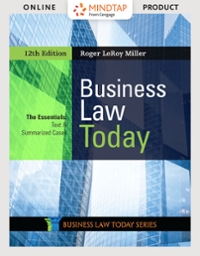Question
Case A: Jackie Brown Company. Suppose you are the economic advisor of Jackie Brown Company, a perfectly competitive company that is suffering economic losses due
Case A: Jackie Brown Company.
Suppose you are the economic advisor of Jackie Brown Company, a perfectly competitive company that is suffering economic losses due to unforeseen continuous drop in the market price. Jackie Brown is a price taker; hence it cannot influence the market price, nor could it change production technology in the short run. You are asked to decide whether the company should shut down its operations or to continue to operate at a loss. Jackie Brown is selling 50 units of output per day, at a price of $20 per unit. The cost of raw material, direct labor, energy, and other variable inputs is about $24000 monthly. Unfortunately, an estimate of Jackie Brown fixed costs is currently unavailable.
So, what is your decision? Justify your answer.
Case B: Jessie Pharmacy.
Jessie, a pharmacist, is planning on opening her own pharmacy. Jessie Pharmacy is expected to generate yearly revenue of $500,000. Jessie will run the pharmacy herself on full-time basis.
Jessie's alternative employment options are as follows:
-Continue to work as a senior medical representative for $50,000 per year.
-Accepts a research position in another company for $70,000 per year.
Jessie expects to spend $350,000 per year on purchasing drugs and cosmetics for resale to her customers. She will also need to hire three employees: an assistant, an accountant and a custodian, for whom the total salaries to be paid are expected to be $48,000 per year. Jessie owns the building in which her pharmacy is supposed to be; however, she could rent out the pharmacystore space for $42,000 per year.
Calculate Jessie's accounting profit and economic profit. In your opinion, should Jessie proceed with opening her own pharmacy? Justify your answer.
Case C: Galaxy Multinational.
Galaxy, a multinational corporation, has two plants, one in the United States and the other in Mexico, and it cannot change the size of the plants or the amount of capital equipment in the short run. The wage in Mexico is equivalent to US $5 per hour. The wage in the U.S. is $25 per hour. Given current employment situation, the productivity per worker in Mexico is 200 units per hour, and the productivity per worker in the U.S. is 400 units per hour.
Is Galaxy maximizing output relative to its labor cost? If not, what should Galaxy do? Justify your answer.
Case D: Apex Company.
Apex is a perfectly competitive firm. It has total fixed costs of $300/day and a daily variable cost schedule in the table below. Apex's product sells for $200 per unit.
Quantity (units)
0
1
2
3
4
5
6
7
8
9
10
Total VariableCost (TVC)
0
100
180
220
300
390
500
640
800
1000
1250
Answer the following questions:
1.What is the profit-maximizing level of output? Calculate Apex's profit.
2.If the market price dropped to $80, what is the profit-maximizing level of output? What is Apex's profit (or loss) in this case?
3.If the market price dropped further to $40, what is the profit-maximizing level of output? What is Apex's profit (or loss) in this case?
4.Comment on your answers to parts (2) and (3).
Case E: Atlas Steel.
With an estimated market share of 60%, Atlas is the market leader in an oligopolistic steel industry. The remaining market share is distributed equally between ten companies. Suppose that one of those ten companies, Norton, attempts to gain market share by undercutting the price set by Atlas.
Calculate the "Four Firm Ratio" and Herfindahl-Hirschman Index "HHI" in the above described market and interpret your answer. What is your opinion regarding the effect of Norton's attempt described above on Atlas's market share: will it increase, decrease, or not affected at all? Justify your answer.
Case F: Pepsi & Coke.
The pie-chart given below shows the annual global market share of Pepsi and Coke for the last five years on average.
Under what market structure do Pepsi and Coke operate? How can you explain the pricing behavior of Pepsi and Coke? Given the obvious market share of both Pepsi and Coke, on what grounds would you justify the multi-billion-dollar annual advertising spending by those two companies?
Step by Step Solution
There are 3 Steps involved in it
Step: 1

Get Instant Access to Expert-Tailored Solutions
See step-by-step solutions with expert insights and AI powered tools for academic success
Step: 2

Step: 3

Ace Your Homework with AI
Get the answers you need in no time with our AI-driven, step-by-step assistance
Get Started


